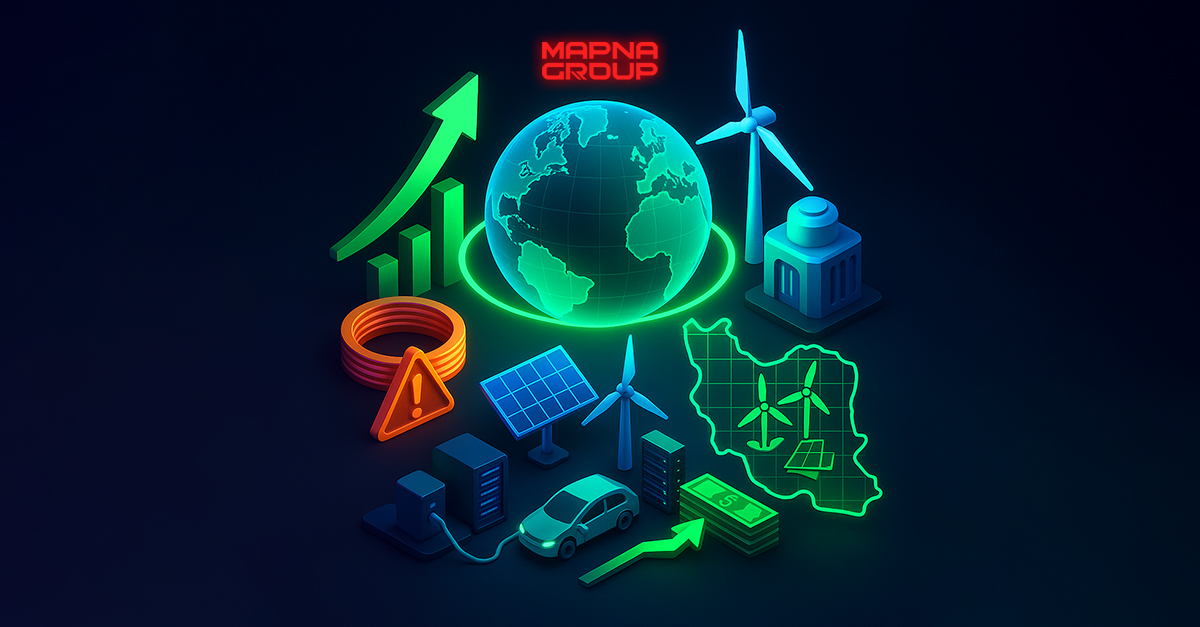According to reports from the International Energy Agency (IEA), global electricity demand grew by more than 4.3 percent in 2024. This rise is largely attributed to the rapid expansion of data centers, artificial intelligence infrastructure, electric transportation, and the increasing need for cooling systems in response to climate change. The buildings sector and technology-driven industries have been key contributors to this growing demand.
In parallel with this trend, renewable energy has gained a significant share in the global electricity generation mix. By the end of 2024, clean energy sources accounted for 40.9 percent of total electricity production, with solar energy leading the way with a 29 percent increase. Analysts predict that by the end of 2025, renewable electricity generation will surpass coal for the first time in history.
Despite the impressive growth of renewables, mounting pressure on the supply chains of critical minerals—such as copper and lithium—has emerged as one of the key challenges in the energy transition. The IEA projects a 30 percent shortfall in global copper supply by 2035, raising serious concerns about the long-term viability of this transition. In response to such constraints, nuclear energy has regained prominence in national energy strategies. The development of Small Modular Reactors (SMRs) in leading countries is accelerating, offering a safe, scalable, and cost-effective solution for providing reliable power during the decarbonization era.
Meanwhile, a surge in government and investor focus on sustainable and high-tech infrastructure pushed global investment in clean energy to an all-time high of $2.1 trillion in 2024—an indicator of how deeply the future of the energy sector is being redefined.
Iran’s energy market, while facing acute challenges, also holds significant untapped potential. A growing imbalance between supply and demand, inefficiencies in the distribution system, and increasing strain on gas and electricity networks are among the country’s most pressing issues.
Official data shows that more than 90 percent of Iran’s power plants still rely on fossil fuels. During the past winter, gas shortages led to production cuts and widespread blackouts in both residential and industrial sectors. In the summer months, skyrocketing electricity consumption—especially due to cooling demand—places additional stress on the grid. These challenges are further compounded by low energy efficiency, aging infrastructure, and a lack of diversity in energy sources, all of which add complexity to Iran’s energy outlook.
Despite the challenges, new opportunities are beginning to take shape. Geographically, Iran is considered one of the most promising countries in the region for developing renewable energy. However, the share of clean energy in the country’s electricity mix remains under two percent. According to the Ministry of Energy, the current installed capacity of renewable power plants stands at approximately 1,450 megawatts as the government aims to raise this figure to 4,800 megawatts by the end of the Iranian calendar year 1404 (March 2026).
In Iran’s complex and volatile energy landscape, the active involvement of companies that operate across electricity generation, technology development, and modern infrastructure has become increasingly vital. MAPNA Group, a long-standing player in the country’s energy, transport, and infrastructure sectors, has in recent years sought to realign its operations with global shifts in the energy industry.
In the power generation sector, MAPNA—with years of experience in thermal power plant development and operation—has begun making strategic moves into emerging areas such as renewable energy, digital process optimization, and smart energy management systems. Although its projects in solar and wind power are still in early stages, they reflect the conglomerate’s intent to contribute meaningfully to the future of Iran’s energy portfolio.
In parallel, MAPNA Group has launched initiatives in energy storage, efficiency optimization, smart grids, and distributed generation. While these activities remain nascent, their alignment with national policy priorities—such as reducing supply-demand imbalances, improving efficiency, and lowering energy intensity—lays a solid foundation for expanding strategic interventions in the coming years.
MAPNA Group, as part of its broader sustainability agenda, has set clear goals for resource management, emissions reduction, and environmental performance improvements across its operational and contractor units. Other focal points include workforce development, supply chain transparency, and enhancing engagement with stakeholders. At a time when the energy sector is confronted with new global trends and regulatory pressures, advancing toward sustainability, diversification, and higher efficiency requires committed and adaptive actors—ones attuned to both local and international dynamics. Organizations that pursue transformation responsibly and progressively will be better positioned to contribute meaningfully to shaping a sustainable future.
